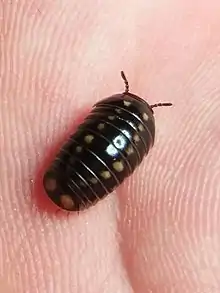| Glomeris tetrasticha | |
|---|---|
 | |
| Scientific classification | |
| Domain: | Eukaryota |
| Kingdom: | Animalia |
| Phylum: | Arthropoda |
| Subphylum: | Myriapoda |
| Class: | Diplopoda |
| Order: | Glomerida |
| Family: | Glomeridae |
| Genus: | Glomeris |
| Species: | G. tetrasticha |
| Binomial name | |
| Glomeris tetrasticha Brandt, 1833 | |
| Synonyms | |
|
List
| |
Glomeris tetrasticha, is a species of pill millipede within the genus Glomeris and family Glomeridae.[1]
Description
The body length of Glomeris tetrasticha is 5–17 mm. The dorsal plates of the species are black or dark brown in colour, possessing yellow spots. The dorsal shield is evenly rounded from the side. G. tetrasticha possesses a thin cuticle that is highly permeable to water.[2]
Distribution and habitat
Glomeris tetrasticha possesses a widespread European distribution, where it can be found within the countries of: Austria, Belarus, Belgium, Czech Republic, France, Germany, Hungary, Italy, Poland, Romania, Slovakia, Switzerland and Ukraine.[3] The species can also be found within European Russia.[3]
Glomeris tetrasticha can be found in a broad range of forest and woodland habitats, including floodplain forests.[2] The peak activity of Glomeris tetrasticha occurs at around 2300 hours, indicating a preference for nocturnal activities. This temporal pattern, with the species being primarily active between 2100 and 0900 hours, aligns with their behaviour of searching for food during the night and seeking shelter in the morning.[2]
References
- ↑ "Glomeris tetrasticha Brandt, 1833". Millibase. 2023-05-31. Retrieved 2023-05-31.
- 1 2 3 Drahokoupilová, Táňa, and Ivan Hadrián Tuf. “The effect of external marking on the behaviour of the common pill woodlouse Armadillidium vulgare.” ZooKeys ,176 (2012): 145-54. doi:10.3897/zookeys.176.2375
- 1 2 "Glomeris tetrasticha Brandt, 1833". Fauna Europaea. 2023-05-31. Retrieved 2023-05-31.